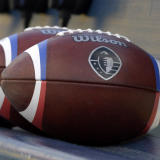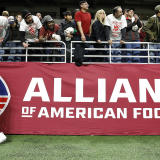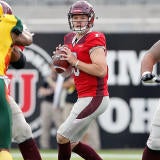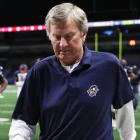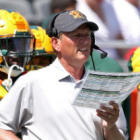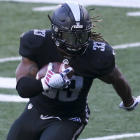After control owner Tom Dundon suspended operations for the foreseeable future, the Alliance of American Football's future is in doubt. Whether the league officially folds or not remains to be seen (AAF employees were told Wednesday would be their last day), but in times of crisis it's important to remember your roots. The AAF's roots are in player development and giving them another shot at the NFL.
Not everyone is going to get that shot, obviously, but there are a few playmakers who could legitimately see the field on Sundays next fall. After following this league for the past eight weeks, here are 10 players that I think fit that description. Production is important, obviously, but it's not the only factor. Players get opportunities based on physical traits, smarts and how well their game translates to the NFL. There are also more than 10 players capable of playing in the NFL, so if you don't see a name on here, just know it's not personal.
Rashad Ross, WR, Arizona Hotshots
He's been the most consistent deep threat in the Alliance and leads the league with seven touchdowns. He has speed to burn, but he's a gritty, tough wideout who has shown he can play through injuries. With his ability to catch short passes and go deep, he has a full route tree at his disposal. Someone will pick up this speedster in the summer.
Wolford and Ross make it look EASY on this 58-yard pass #GoShots #AZvsSA pic.twitter.com/pw4lKqwZVV
— Arizona Hotshots (@aafhotshots) April 1, 2019
Charles Johnson, WR, Orlando Apollos
The other great wideout in the AAF is Johnson, who has become Garrett Gilbert's favorite target. He leads the AAF in receptions (45) and yards (687), and is second behind Ross with five touchdowns. Short-to-intermediate routes are his specialty -- his comeback routes have been hurting defensive backs all season long -- but he does have the ability to go over the top. At 30, he's probably on his last NFL contract if he gets picked up, but he'd be a valuable asset to any team.
Garrett Gilbert, QB, Orlando Apollos
From one Apollo to another, Gilbert has been the frontrunner to be the Alliance's offensive MVP from Week 1. Gilbert's story is well-told: he's a former blue-chip prospect who committed to Texas out of high school, but things never worked out with the Longhorns. He then transferred to SMU and bounced around the NFL as a backup for a number of years. Now that we have some tape on him, he should at least get a decent backup gig. He has the arm and the savvy to command an offense. He can also move some with his legs. However, he's had a couple of multi-interception games over the past few weeks, so decision-making is still a bit of an issue.
Jamar Summers, CB, Birmingham Iron
Summers has been banged up recently with a knee injury, but he's been one of the top corners in the AAF all year long. Pro Football Focus grades him as one of the two best corners in the league. He's a tough-nosed, tenacious defender who defines what it means to be a lockdown corner. He didn't get much of a look from the Steelers as an undrafted free agent in 2018, but he obviously has ability.
WATCH: Steve Spurrier says the @aafAPOLLOS should be champions, if this is indeed the end of @TheAAF.#Champions #Apollos #Orlando #AAF #WFTV pic.twitter.com/KumJjOe2uA
— Christian Bruey (@CBrueyWFTV) April 2, 2019
Trent Richardson, RB, Birmingham Iron
Laugh if you must, but Richardson has been getting better every week. His yards per rush average (2.9) still isn't good, but some of that can be attributed to his offensive line. He's a red zone/goal line monster with 11 touchdowns and he's shown better wiggle than you'd expect out of the backfield as a receiver. He's never going to be an NFL team's No. 1 option, which was a problem considering he was a first-round draft pick coming out of Alabama, but he's proven to be a capable role player in third-down/short-yardage situations.
Demontre Moore, DE, San Diego Fleet
Moore has made a real case to be the Defensive MVP of the Alliance. He's tied for second with seven sacks and at one point was averaging a league-best seven quarterback pressures per game. Yes, offensive lines across the AAF have taken more time to develop, but Moore has been a wrecking ball in the backfield from the get-go. He has size (6-foot-5, 260 pounds) and plenty of initial burst combined with moves to make him one of the most feared edge rushers in the AAF.
Keith Reaser, CB, Orlando Apollos
Other than Summers, Reaser has been the best corner in the AAF. Orlando is considered an offensive-minded team, but Reaser is a big reason why the Apollos rank second in passing defense and points allowed. He has three interceptions, two of which he's taken back for touchdowns. He's been one of the highest-graded corners from PFF, having allowed just a 21.2 passer rating through seven weeks.
Trey Williams, RB, San Antonio Commanders
Here's an example of a player who isn't owning the stat sheet, but his game may translate well to the NFL in a complementary role. Kenneth Farrow has been San Antonio's primary back with Williams and David Cobb serving as 2A and 2B. But Williams has been a coaching favorite from the beginning. He's best among San Antonio's running backs with 5.1 yards per carry and he's a big-time threat in the open field who can make defenders miss and create his own yards. He's absolutely capable of being one of two or three running backs on an NFL roster.
DeMarquis Gates, LB, Memphis Express
Let's put it this way: he's one of Mike Singletary's favorite players. Gates has been everywhere for Memphis' defense, which has been one of the best in the Alliance in creating takeaways. He leads the AAF with 52 tackles and he's everywhere, all the time, it seems. An instinctive, disruptive playmaker, Gates has shown the kind of nose for the football that gets the attention of NFL GMs and coaches.
Derron Smith, DB, San Antonio Commanders
The Commanders' secondary has been suspect this season, but that's not Smith's fault. He's a bona fide safety net who had the highest coverage grade in the Alliance through seven weeks. He's also shown the ability to be a ball hawking safety (three picks) who can come up in support if needed. General manager Moose Johnston raved about him.


